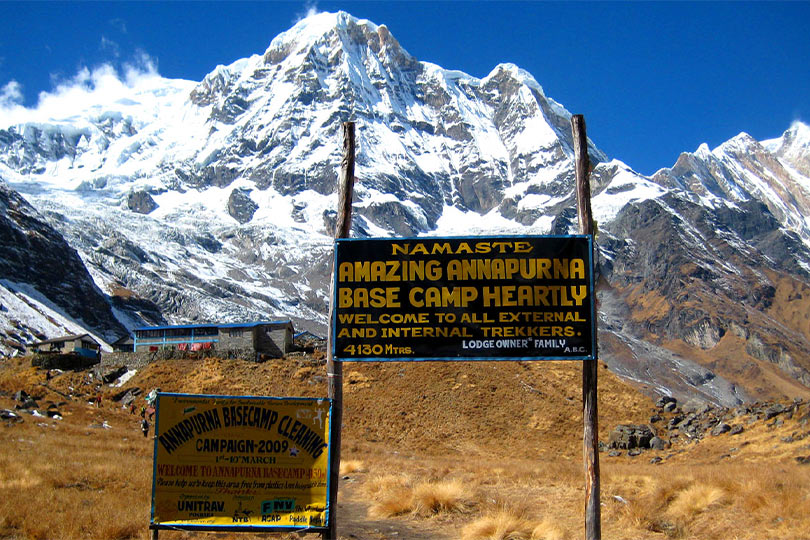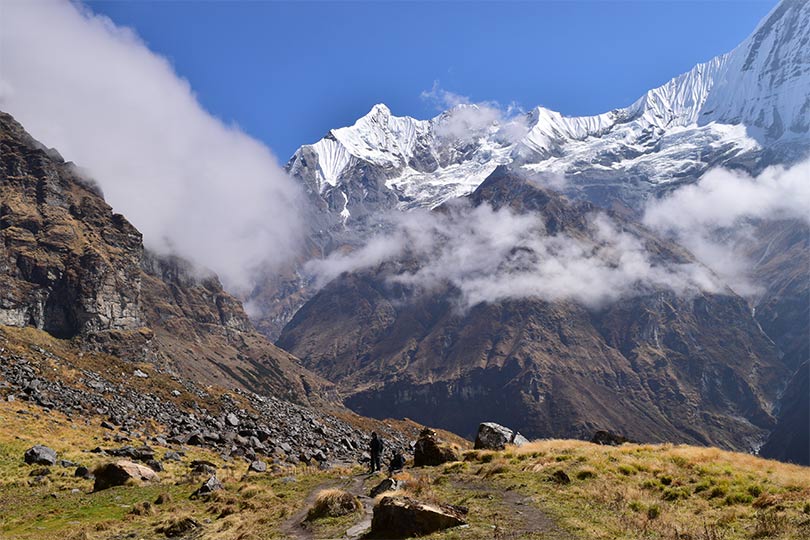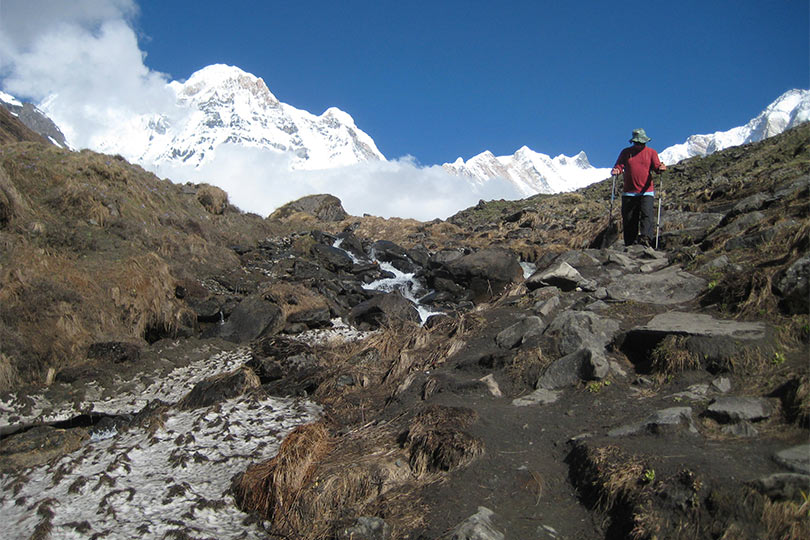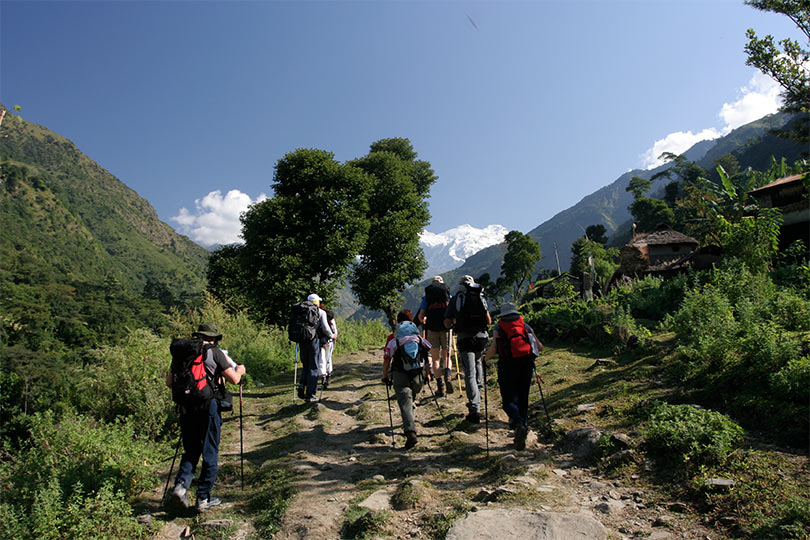The Annapurna Base Camp Trek is undoubtedly one of the best treks in Nepal, boasting breathtaking views of the Himalayas, rich cultural experiences, and encounters with the friendly Gurung people in their pristine villages. It is a dream destination for any trekker who desires to set foot on the base camp of the world’s 10th highest peak, Mt. Annapurna (8,091m/26,545ft). However, before embarking on this journey, it is important to be aware of the difficulties that the Annapurna Base Camp trek entails.
While this trek can be moderate with less challenging, it is not impossible. With good health and determination, any trekker can overcome the obstacles along the way. Learn more about the Annapurna Base Camp trek difficulty and how to overcome its barriers in this guide.

Like most treks in Nepal such as Annapurna Circuit trek, this trek might be quite demanding. However, with proper physical and mental preparation for Annapurna Base Camp trek, it is achievable as well as enjoyable.
The Annapurna Base Camp, which is situated at an elevation of 4,130m/13,549ft, is a popular trekking trail in Nepal after Everest base camp trek. This trek is popular between both novice and experienced trekkers. Likewise, both solo and group trekkers can trek this region. Passing endless stone staircases and long tiring walks is challenging, but still this trek is not as difficult as many other treks in Nepal. So, traveling in Nepal and getting to the mountainous region can be equally adventurous and exciting.
- Annapurna Base Camp Trekking Grade
- Comparison Table
-
Challenges and Risks of Annapurna Base Camp Trek
- 1. Duration of Annapurna Base Camp Trek
- 2. Distance of Annapurna Base Camp Trek
- 3. Altitude Sickness
- 4. Annapurna Base Camp Trekking Trail
- 5. Weather of Annapurna Base Camp
- 6. Annapurna Base Camp Trek without Guide & Porter
- 7. Budget Management Difficulty
- 8. Packing List for Annapurna Base Camp Trek
- 9. Type of Trekkers
- Is Annapurna Base Camp really a Difficult Trek?
- Tips to Overcome Annapurna Base Camp Difficulties
Annapurna Base Camp Trekking Grade
Discover the difficulty of Annapurna Base Camp Trek, which takes you up to an elevation of 4,130m/13,549ft. While considered a moderate trek, it still has its challenges, including steep and rugged trails, walking over stone stairs, and continuous walking for 5 to 6 hours per day. However, with patience, confidence, and physical fitness, the trek is easily achievable. This guide provides essential information on the Annapurna Base Camp trek difficulty and tips on how to overcome its challenges.
Comparison Table
Nepal is a paradise for Himalayan treks. It has thousands of popular trekking destinations, which have been able to captivate the attention of trekkers with its charm and beauty. All those trekking destinations vary from each other because of the duration, distance, difficulty level and so on. Below we have presented a table to compare the major factors of the most chosen trekking destinations in Nepal.
| Trip Name | Hiking Duration | Total Walking Hour (approx.) | Difficult Level |
|---|---|---|---|
| Annapurna Base Camp Trek | 8 Days | 42 – 47 | Moderate + Demanding |
| Annapurna Circuit Trek | 18 Days | 81 – 96 | Demanding |
| Annapurna Poonhill Trek | 5 Days | 23 – 26 | Light + Moderate |
| Everest Base Camp Trek | 12 Days | 48 – 57 | Demanding |
| Manaslu Circuit Trek | 14 Days | 74 – 89 | Demanding |
| Kanchenjunga Trek | 18 Days | 84 – 102 | Demanding |
If you have a limited time in Nepal, then it is best for you to either choose Annapurna Poonhill Trek or Annapurna Base Camp Trek as it will introduce you to the cultural and natural beauty of the Himalayan region beginning from 5 to 9 days.
Challenges and Risks of Annapurna Base Camp Trek
Embarking on the Annapurna Base Camp trek may not be incredibly challenging, but there are still factors that can affect your journey, such as duration, altitude sickness, and trekking season. To have a successful trek, it’s essential to understand the difficulties and be prepared with prevention tips. This guide provides essential information on the Annapurna Base Camp trek difficulty and offers tips to overcome any challenges.
Here, we have enlisted the possible factors determining the Annapurna Base Camp trek difficulty.
1. Duration of Annapurna Base Camp Trek
Annapurna Base camp trek usually takes 11 to 14 days to complete, but if you are short on time and want to do it within a short time, you can complete this trek in 8 to 9 days. On average, you have to walk for 5 to 6 hours daily. However, it can even take around 7 to 8 hours to get to your day’s destination if you are not used to walking or hiking. This could lead you to anxiety and other various problems.

Annapurna Base camp trek itinerary depends upon the packages designed by different trekking agencies in Nepal. You can shorten or prolong the total trekking duration as per your interests. However, if you go for longer trekking packages, you will have enough time for rest and sightseeing.
To overcome the Annapurna Base Camp difficulty associated with duration, trekkers need to increase their stamina and day-to-day walking capability. They should try long-distance walking, make ascents and descents in uphill and downhill trails, go hiking, and exercise your body. All these preparations will help you get used to walking and make your trip more comfortable.
2. Distance of Annapurna Base Camp Trek
One of the major determining factors of Annapurna Base Camp difficulty is its distance. This trek covers 115km in total where you will be walking 10 to 20 km each day. The distance covered by this trek is short as compared to other long-distance treks like Manaslu Circuit Trek, Annapurna Circuit Trek, Kanchenjunga Trek, and many others. An experienced trekker can cover the day-to-day walking distance sooner, but an inexperienced trekker may take more time. So, for the beginners, short Annapurna Base camp Trek is probably the best.
If you are trekking in the mountainous region for the first time, then always choose the 11-14 days Annapurna Base Camp itinerary. This will give you more days so that you can complete the trek even if you walk at a slow pace.
3. Altitude Sickness
Whenever you are trekking in a high-altitude region, there is always a possibility of being hit by altitude sickness. Most of the Annapurna Base camp itinerary begins from Kathmandu, situated at an altitude of 1300m /4,265ft and ends up reaching up to 4130m /13,549ft within just a few days. The level of oxygen is lower at higher altitudes so it will be very hard to adjust your body in a new environment. Once you cross 3,000m/9,842ft, you may start to feel uncomfortable with the new environment and elevation. You might get symptoms of altitude sickness like headache, diarrhoea, dizziness, loss of appetite, vomiting, shortness of breath, and so on. Such problems will certainly make your overall trip quite a difficult experience.

Even though solo trek to Annapurna Base Camp is possible, it is always best to hire a guide for ABC trek. You will have someone to whom you can inform about the changes occurring in your body because of symptoms of altitude sickness.
High-altitude can create serious problems for some trekkers. Remember, ignoring the symptoms of altitude sickness will only worsen the situation. So, whenever you start noticing any of these symptoms, it is best to return to a lower altitude region. Also, we recommend that you take medicine like Diamox, which helps in preventing altitude sickness. In addition, keep yourself hydrated, avoid smoking and alcoholic items, maintain a balanced diet, and acclimatize to minimize the possible consequences of altitude sickness.
4. Annapurna Base Camp Trekking Trail
Annapurna Base Camp Trekking trail is not as hard as other mountainous trails. However, there are lots of twists and turns, ups and downs, rocky boulders, and steep stone steps, which may add to Annapurna Base Camp difficulty. This trek doesn’t demand the requirement of any fitness level, but you should at least be in good shape and possess good stamina to pass through the moderately difficult hiking trail. Walking over 3300 stone steps and covering a long distance every day will surely exhaust the trekkers.

To minimize the risks associated with trekking trails, you should always be aware about your physical strength. Don’t try to push yourself too hard as it will only make the trip worse. We recommend you keep a slow pace and always have someone by your side like Annapurna Base camp guide who can provide guidelines about ways to walk safely even in a difficult route. Additionally, you should always stay hydrated, maintain a balanced diet, boost up your energy, and pack some energy boosters.
5. Weather of Annapurna Base Camp
Annapurna Base Camp difficulty is also determined by the weather and temperature of this region as the weather in the Himalayan region is unpredictable. In winter (December, January, and February), drastic changes occur in Annapurna Base Camp weather as the temperature ranges between 9.3°C/48.74°F to -20°C/-4°F. The coldness becomes unbearable and creates difficulty while trekking. Most of the teahouses in higher-altitude areas remain closed. Likewise, in summer/monsoon (June, July, and August), the temperature ranges between 19°C/66.2°F to 4°C/39.2°F which results in strong haze from the sun and heavy rainfall.

If you want less traffic on the trekking trail, then plan your trip in summer or monsoon with proper preparation. However, we recommend you choose either autumn (fall) or spring for a wonderful experience.
Among all four seasons, autumn or fall (September, October, and November) and spring (March, April, and May) is considered as the best time to trek Annapurna Base camp. During these seasons, the weather remains calm, temperature is pleasant, and visibility of the mountains is clear. Moreover, the days become bright, and you will be able witness the green cultivable fields, and the flora and fauna on the trails. So, Annapurna Base Camp weather may make trekking difficult, but if you prepare yourself beforehand, you can complete the trek without any hassles.
6. Annapurna Base Camp Trek without Guide & Porter
Most of the trekkers plan for Annapurna Base Camp trek without a guide and porter. Remember, trekking is fun only when you get to know more about each destination, villages, and the local people and their cultures. But, if you visit this region on your own, there will be no one to elaborate about the historical sites, narrate stories or translate the local language. Likewise, you can’t get to the best viewpoint of Annapurna region without the help of a guide. Moreover, absence of a porter will increase your burden giving you less time for sightseeing. Thus, trekking ABC without a guide will add the difficulty and make your trip less exciting.
Trekking to Annapurna Base Camp with a guide helps boost up the local economy and break the language barrier. It also provides unique cultural experience, sense of security, and a hassle-free trekking experience.
There are no restrictions regarding solo trek to Annapurna Base Camp but hiring a guide for Annapurna Base Camp trek is always the best option for both safety and exploration purposes. Annapurna Base Camp difficulties can be minimized if you are with an experienced and qualified guide. Although this trek doesn’t have any technical sections, there are some rough and rocky sections. So, hiring a porter is indeed very helpful.
7. Budget Management Difficulty
Annapurna Base Camp is not an expensive trekking destination. The Annapurna Base Camp trek cost varies as per the itinerary, chosen route, number of days, and so on. If you consider the remoteness of this region, then the cost of accommodation and food is not so expensive. However, once you get to the higher altitude, the cost of everything from bottled water to accommodation increases more than threefold. So, if you don’t succeed in managing the budget, you may face the difficulty in fulfilling your personal expenses including food, water, and so on.
The reason behind the expensive price in higher altitude regions is because all the materials must be carried on horses, mules, donkeys, and even porters. There is no availability of motorways in the Himalayan region, except at some places. Increased cost of transportation leads to the higher price of goods and services. Also, you can’t get access to any ATMs and bank services in the higher-altitude region. Thus, you must carry enough cash with you while embarking on the journey to make your trip comfortable.
8. Packing List for Annapurna Base Camp Trek
While trekking in this region, you must make sure that you have a proper packing list for Annapurna Base Camp Trek. Packing a bag with essential items for around 2 weeks can be demanding itself. Likewise, not packing the essential gears and equipment can be inconvenient. Remember, you will not be able to buy anything that you require for the trek on the Annapurna Base Camp trekking trail. Thus, packing all the essential gears and equipment for Annapurna Base Camp trek is a must.
Make sure to invest in reliable and qualitative clothing and shoes as your whole travel journey entirely depends upon them.
If you avoid excess packing and focus on the right clothing, then you can enjoy a comfortable trip. Since the weather of Annapurna Base Camp is unpredictable, it is always best to pack both light warm clothes and thick woolen clothes. Don’t forget right shoes are key for increasing the success rate of Annapurna Base Camp Trek. So, always try on your shoes and walk with them before the actual trek because a new pair of shoes can result in blisters. Thus, make your backpack as light as possible by including only the essential items.
9. Type of Trekkers
Annapurna Base camp difficulty also depends on the experience of the trekkers. If you are skilled and experienced, then Annapurna Base Camp trekking trails will not be too hard. To be precise, this trek is easily achievable and comfortable for those trekkers who can walk on rocky terrains continuously for 5-6 hours per day. However, for the novice trekkers, it will take more time to cover the same distance as compared to experienced trekkers. Also, it will be difficult for them to walk in the rough and rocky trails.

To avoid difficulties for beginner trekkers, we recommend developing a habit of daily uphill and downhill walking to increase stamina. Additionally, hiring a guide and porter can make your trip more enjoyable and less stressful. At high altitudes, a porter can share your load so that you won’t have to bear the full weight alone. Hiring an experienced guide from an authorized and reputable trekking company for the Annapurna Base Camp trek ensures both your safety and security.
Are you ready for an unforgettable journey to the Annapurna Base Camp?
Let the adventure specialists at Himalayan Glacier help you plan the trip of a lifetime. Our team will work with you to design a customized itinerary that fits your unique needs and preferences. Simply share your requirements, available dates, and desired experiences with us, and we will take care of the rest. Contact us today to get started on your Annapurna Base Camp trek!
Is Annapurna Base Camp really a Difficult Trek?
The answer to this question depends on the perspective of every and their previous trekking experience. Most Himalayan treks in Nepal involve undulated paths and lower oxygen at high altitudes, which causes stress for any trekker. However, compared to other trekking destinations in Nepal, this trek is much easier, shorter, and located at comparatively lower elevations. If you are determined and physically fit, you can reach there easily.
Thus, Annapurna Base Camp trek is one amongst the many classic treks in the Himalayas. It is daring enough, but not so challenging that only body builders can complete it. Overall, it is a moderate level trek. Many trekkers attempt it as the first Himalayan trek where the scenery is out of the world and is sure to bring the tears of ecstasy on completion.
Tips to Overcome Annapurna Base Camp Difficulties
- Take frequent rest and breaks while walking. Always keep a slow pace.
- Always drink plenty of water and focus on hydrating your body.
- Don’t smoke or consume any alcoholic drinks while you are on the trekking trail.
- Build up your stamina and endurance by exercising a lot.
- Stay alert about the quality of food and water.
- Never forget that acclimatization is key for success of Annapurna Base Camp Trek, so acclimatize properly.
- Remember to pack the first aid kit box along with your prescribed medications.
- Always carry energy-imparting chocolates and snacks.
- Plan your trip wisely by hiring a guide and porter from a trusted trekking agency.
- If you have problems walking down a hill, then always wear a knee cap.
- Keep yourself updated about the current affairs of the trekking region like weather, temperature and so on.
- Always follow the main trails. Don’t go for shortcuts or never-trekked trails as it might end up with bad consequences.
If you want to try trekking in Nepal and explore the beautiful Himalayan regions, then Annapurna Base Camp Trek must be on your bucket list. It is always fun to be part of varied flora and fauna, cultural and natural beauty by being far from the hustle and bustle of city life. This trek is one of the best trekking destinations in Nepal where more than 30,000 people travel every year. Despite all the difficulties of Annapurna Base Camp, the closest view of the Mt. Annapurna, Mt. Makalu, Mt. Dhaulagiri, and others will make you forget about all the tiresome days.
We at Himalayan Glacier have been designing tailor-made itineraries for our wonderful clients to ensure safe trips to Annapurna Base Camp for several years. Our standard Annapurna Base Camp itinerary includes an experienced guide along with a porter who will provide you with guidance and support while introducing you to the rich local Gurung culture. With our several years of experience in the Annapurna region, we know the best places for overnight stays, local services, and activities to experience. So, if you are considering traveling to the Annapurna region, please contact us and we will plan a memorable trip for you.






